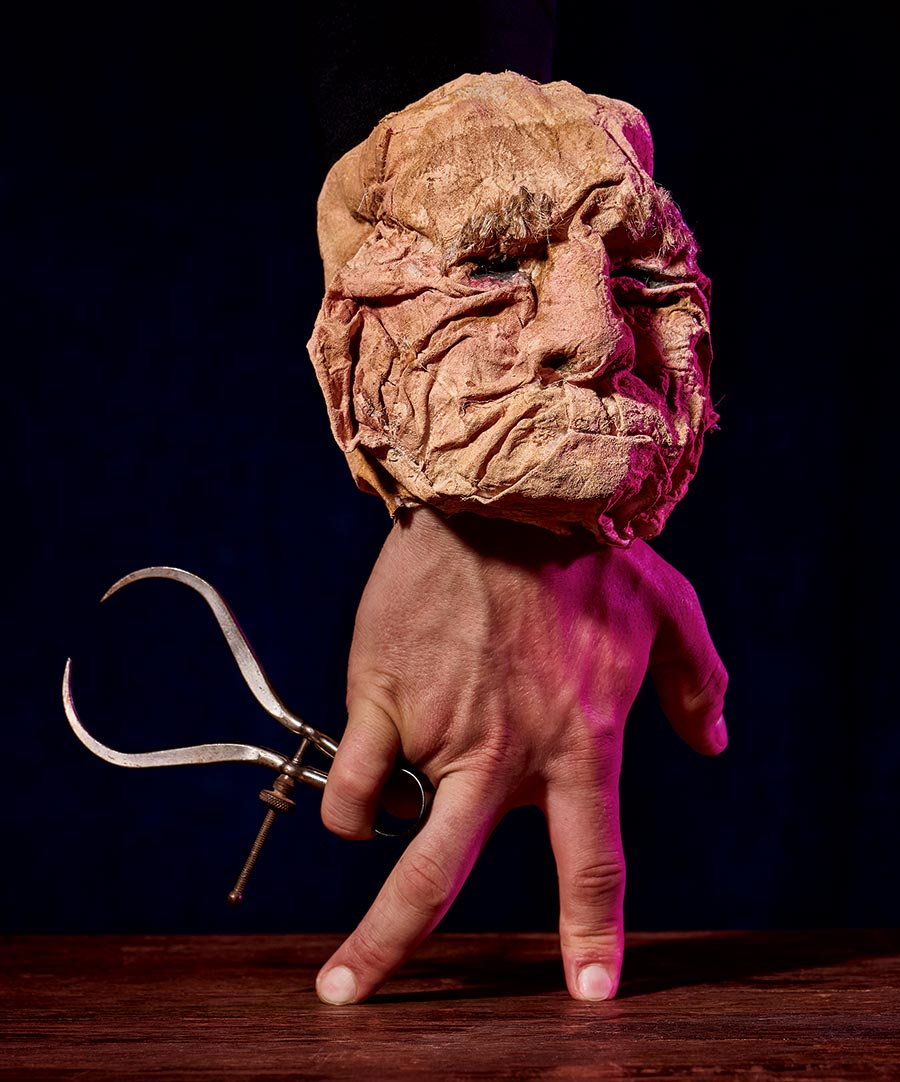You’re about to embark on a tour of a masterwork designed by the great architect Milton Harrow. Until now, the house has been closed to the public. Your guide is wearing a grotesque mask, with cavernous eyes and warped cheekbones. Then things start to go wrong. The guide disappears, and suddenly you’re on your own, exploring The Walls of Harrow House, a new 50-minute interactive show produced by the experimental theater company Rough House.
In eight shadowy rooms throughout the basement of Noble Square’s Chopin Theatre, audiences encounter dozens of puppet creatures — human-size figures, scurrying infant heads, and crawling intestines so large it takes several puppeteers to manipulate them. “At moments, it’s like alien movies where you have to decide if a thing will eat you or try to be your friend,” says Grace Needlman, the show’s lead puppet designer.
Advertisement
Though Harrow House channels the chills and thrills of a haunted house, the production and its fictional architect have an unlikely inspiration: Frank Lloyd Wright. For Mike Oleon, Rough House’s founding artistic director, the idea for the show began to germinate during a 2007 visit to Wright’s Hollyhock House in Los Angeles. “I remember marveling at how terrifying it looked,” he says, “like a temple created to worship an evil elder god.”
Harrow House frames Wright as a domineering figure who commanded an unhealthy reverence. “Wright thought he could engineer society into his vision of what he thought American culture should be,” says co-artistic director Claire Saxe. That had an effect on both his architecture and the people who inhabit it. “For all his brilliant ideas, Wright also had narrow-minded or even oppressive ideas of what architecture should be,” Oleon adds, pointing out that the architect’s kitchens are notoriously too small. Harrow House distorts Wright’s iconic aesthetic, taking his meticulously balanced objects and rendering them menacingly askew. Oleon and Saxe manipulate the precisely symmetrical angles of a Wright sconce, for instance, so that it projects spooky shadows across the walls.

Still, Harrow House, written by Saxe and Mark Maxwell, isn’t a narrative-driven argument about architecture. Audiences can piece together the show’s themes, but what they experience will be less of a story than a journey through the uncanny. They can choose to stay together or break away and delve deeper into increasingly scary chambers. Each room reveals different snippets of the tale: In the architect’s mysterious absence, his acolytes battle over his legacy while turning into horrific creations.
Harrow House’s creators have faced a horror of their own: mounting a production with a dozen performers in so many spaces with so many objects and bodies, human and otherwise. “About 90 percent of the work on this show is spreadsheets — who’s available to take off this puppet and put on that puppet, how many puppeteers do we have available to make this one creature come to life,” Oleon says. “The show’s world is much larger than any one audience member can experience in a single visit.”
The artists also had to get creative with the show’s finances. Almost 30 people have worked on Harrow House — more than twice the number for a typical Rough House play. To pay them, the four-year-old company had to more than double its usual budget, to upward of $50,000. For help in financing that, Rough House held a Kickstarter campaign, which raised close to $22,000. Rough House hopes the production will grow into an annual tradition. “Our great hope with this show is that it becomes our Nutcracker or Christmas Carol and provides some stability for the company,” Oleon says.
Advertisement
E.T.A. Hoffmann and Charles Dickens never imagined anything quite as strange as Harrow House. For instance, the puppeteers are always visible. A puppet’s head sits atop the hand of the person working it, who, simply by extending his or her arm, makes the figure’s neck grow freakishly long. “If audiences know the puppeteers are bringing life to something and still fully believe in it, it becomes more incredible,” Oleon says. “We like to have audiences think they’re on the rails with us, then completely fly off of them, and then find themselves back on again — or on a different roller coaster altogether.”
Details:The Walls of Harrow House Oct. 11–Nov. 3. Noble Square. Chopin Theatre. $15–$25. roughhousetheater.com



